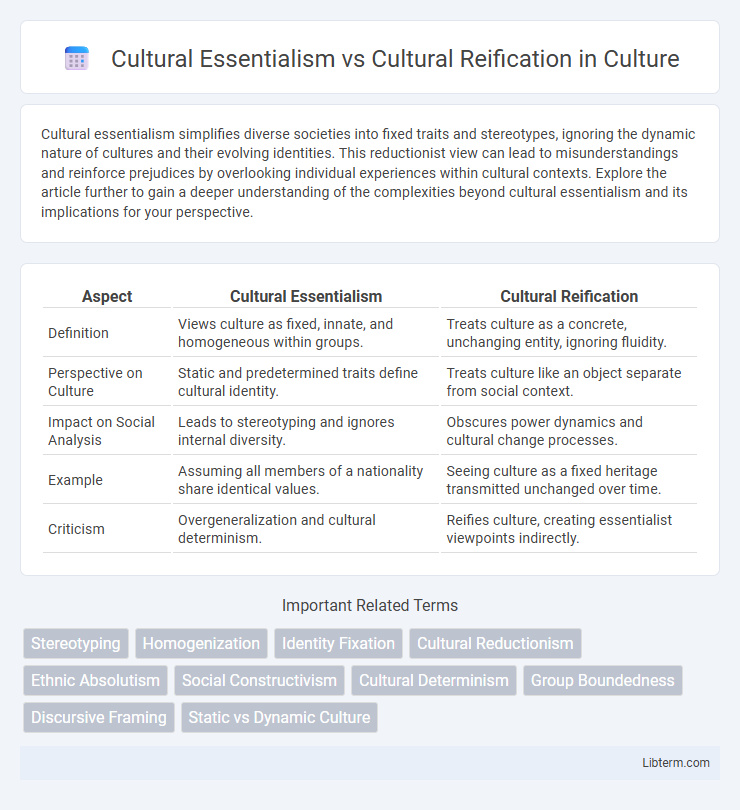Cultural essentialism simplifies diverse societies into fixed traits and stereotypes, ignoring the dynamic nature of cultures and their evolving identities. This reductionist view can lead to misunderstandings and reinforce prejudices by overlooking individual experiences within cultural contexts. Explore the article further to gain a deeper understanding of the complexities beyond cultural essentialism and its implications for your perspective.
Table of Comparison
| Aspect | Cultural Essentialism | Cultural Reification |
|---|---|---|
| Definition | Views culture as fixed, innate, and homogeneous within groups. | Treats culture as a concrete, unchanging entity, ignoring fluidity. |
| Perspective on Culture | Static and predetermined traits define cultural identity. | Treats culture like an object separate from social context. |
| Impact on Social Analysis | Leads to stereotyping and ignores internal diversity. | Obscures power dynamics and cultural change processes. |
| Example | Assuming all members of a nationality share identical values. | Seeing culture as a fixed heritage transmitted unchanged over time. |
| Criticism | Overgeneralization and cultural determinism. | Reifies culture, creating essentialist viewpoints indirectly. |
Understanding Cultural Essentialism
Cultural essentialism posits that cultures possess fixed, inherent characteristics that define their identity and behavior, often overlooking internal diversity and historical change. This perspective can lead to stereotyping by assuming that individuals within a culture uniformly share the same traits or values. Understanding cultural essentialism requires recognizing how such rigid categorizations simplify complex social realities and affect cross-cultural interactions.
Defining Cultural Reification
Cultural reification refers to the process by which abstract cultural concepts, practices, or social constructs are treated as concrete, immutable realities, leading to the misunderstanding that culture exists independently of individuals and their interactions. This phenomenon reinforces stereotypes and obscures the dynamic, evolving nature of culture by presenting it as fixed and homogeneous. Unlike cultural essentialism, which attributes inherent, unchangeable traits to cultural groups, cultural reification emphasizes the social construction and objectification of culture as a perceived natural entity.
Key Differences Between Essentialism and Reification
Cultural essentialism views culture as a fixed set of inherent traits defining a group's identity, while cultural reification treats culture as a concrete, unchangeable object imposed on individuals. Essentialism emphasizes attributed characteristics as intrinsic and stable, whereas reification involves abstract cultural ideas becoming perceived as tangible realities. The key difference lies in essentialism's attribution of inherent qualities versus reification's process of objectifying and solidifying cultural concepts.
Origins and Historical Contexts
Cultural essentialism originates from early anthropological theories in the 19th century, emphasizing fixed and inherent traits within cultural groups, often rooted in colonial and ethnocentric perspectives. Cultural reification emerged as a critical response in the mid-20th century, highlighting how culture is constructed and institutionalized through social practices rather than static essences. Both concepts are deeply tied to historical contexts of power, identity formation, and debates over cultural representation in postcolonial and critical theory discourses.
Effects on Identity and Belonging
Cultural essentialism simplifies identity by attributing fixed, homogeneous traits to cultural groups, which can limit individual expression and foster exclusion. Cultural reification treats culture as a static object, reinforcing stereotypes and hindering cross-cultural understanding. Both perspectives impact belonging by constraining personal identities within rigid cultural boundaries, reducing social cohesion in diverse societies.
Cultural Essentialism in Media Representations
Cultural essentialism in media representations reduces diverse cultures to fixed, simplistic traits, perpetuating stereotypes that ignore internal variation and historical context. This approach often frames cultural identities as monolithic and unchanging, which reinforces prejudiced narratives and limits audience understanding. Media that rely on cultural essentialism contribute to the marginalization of groups by promoting reductive portrayals rather than complex, authentic stories.
Cultural Reification in Social Policy
Cultural reification in social policy involves treating culture as a fixed, homogeneous entity, which oversimplifies complex social realities and reinforces stereotypes. This approach can lead to policies that rigidly categorize communities without acknowledging internal diversity or social dynamics, ultimately restricting social mobility and perpetuating inequality. Recognizing the fluid and constructed nature of culture enables more nuanced, inclusive policy frameworks that address specific needs and promote social justice.
Critiques and Controversies
Cultural essentialism faces criticism for oversimplifying complex identities by attributing fixed, homogeneous traits to entire groups, which can reinforce stereotypes and ignore individual diversity. Cultural reification is controversial for treating culture as a static, unchanging entity, which can legitimize power imbalances and cultural hierarchies by presenting cultural constructs as natural and immutable. Both approaches are challenged for obscuring historical context and social dynamics that shape cultural expressions and identities.
Impacts on Cross-Cultural Communication
Cultural essentialism simplifies groups into fixed, homogeneous traits, often leading to stereotyping and misinterpretation in cross-cultural communication. Cultural reification reinforces these static images by treating cultural traits as concrete and unchanging, hindering genuine understanding and adaptability. Both approaches impede effective dialogue by fostering assumptions rather than encouraging nuanced engagement with cultural diversity.
Moving Beyond Binary Approaches
Moving beyond binary approaches in cultural studies challenges the limitations of cultural essentialism, which often reduces identities to fixed traits, and cultural reification, which solidifies culture into static, unchanging entities. Emphasizing fluidity and hybridity, contemporary scholarship advocates for recognizing the dynamic and negotiated nature of cultural identities shaped by historical, social, and political contexts. This perspective facilitates more nuanced analyses that avoid oversimplification and promote inclusive cultural understanding.
Cultural Essentialism Infographic

 libterm.com
libterm.com